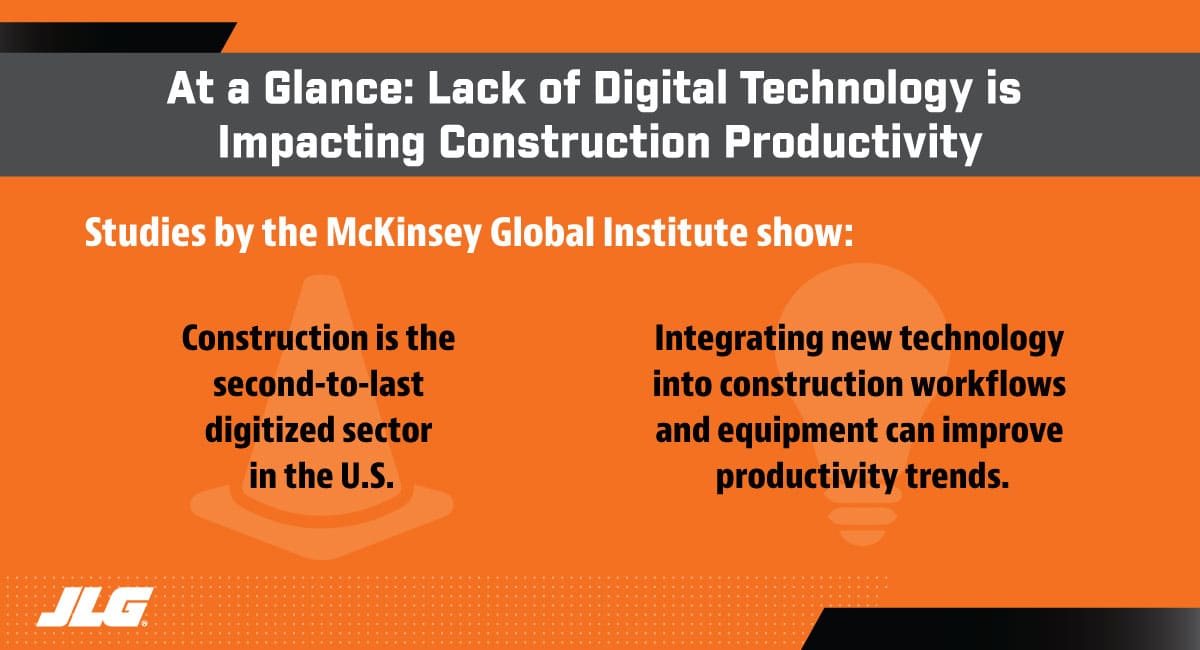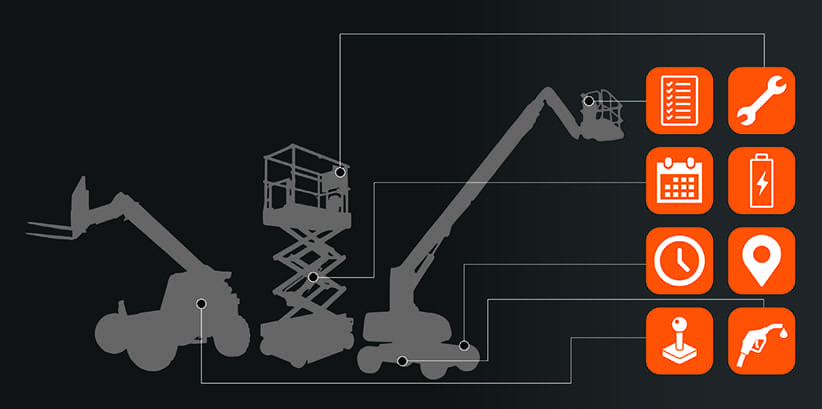We can’t continue working this way.
Productivity in construction is severely lagging other industries — and the growth of the economy as a whole.
Smart construction technology that quickly connects contractors to actionable information has the power to change all that.

Contractors want to know how they can get work done faster, reduce equipment downtime and crew overtime, and eliminate tedious tasks and duplication of efforts.
According to a 2017 report by the McKinsey Global Institute, infusing new technology into construction workflows and equipment is one of the key factors that can reverse poor productivity trends.
However, many contractors still can’t quite grasp the potential of the connected job site.
It sounds distant and complicated and not entirely relatable to how it can solve present-day pain points.
But contractors can take steps now to put them on the path of productivity gains. Embracing digitization overall — both at home and at work — will ease this significant transition, says Rob Messina, senior vice president of product development and product management at JLG Industries.
“We're living through an evolution,” Messina says.
So how can smart technology in construction impact your productivity and increase your profitability? Read on to find out.
Providing a Clear Picture of Connected Benefits
First, we need to understand what a connected job site is, and what it is not.
Most construction equipment available today offers the ability for one-way communication.
“The job site of the future is about two-way, interactive communication with machines,” Messina says.
Two-way communication links equipment to operators, remote third parties, and other machines on the construction site in order to automate certain functionalities, speed documentation, and deliver information for crews to make faster, more accurate decisions.
Think about today’s smartphones, Messina says.
In just over a decade, one device has eliminated the use of many. You used to need a watch, camera, map, music player, TV, DVD player, computer, calculator — now all of those tools, and more, are combined in your smartphone.

That is where construction equipment, including MEWPs and telehandlers, are headed.
In the future, equipment on the job site will reduce dependence on manual entry of key utilization metrics, manual inspections and operation, and manual diagnostics. The machine will include all that functionality.
This transition to smart construction technology is happening in stages with “moments of autonomy” making their way into equipment to help offset a construction workforce that is increasingly nearing retirement yet facing a lack of skilled labor professionals entering the field.
“It's not going to be like one day I'm on a totally disconnected job site, and tomorrow I walk out and it's completely a new world,” Messina says. “This stuff is actually happening now.”
In our consumer lives, we are increasingly embracing connected technology.
We have smart speakers, watches, fridges, thermostats, doorbells, lights, and more. Our cars are mobile computers, collecting and sharing streams of data.
And yet, in the construction industry, we’re still trying to connect machines, Messina says.
Removing the Roadblocks to Productivity
What’s puzzling is that the capability to connect to machines has existed for over a decade, he says. JLG first introduced its ClearSky™ telematics in 2008. Why is it taking so long for adoption?
The problem is multi-pronged, Messina says.
Part of it is standardization challenges that remain still today, which impact contractors who use mixed equipment fleets.
Another contributing factor is the overall lack of digitization in the construction industry. According to a 2015 report, construction is the second-to-last digitized sector in the U.S., trailed only by agriculture.
Messina says that OEMs share some of the blame for that. JLG was at the forefront with introducing telematics, but he says looking back, we could have provided better functionality, training, and support for leveraging the capabilities offered by ClearSky.
“We enabled the connection, but we didn’t cultivate its growth within the access equipment industry to its fullest potential,” he says. “Plenty of innovations fall flat when they don't do all the things that are required to get adoption.”
Messina says 16,000 JLG assets are connected today, but that’s just the starting point.
What would actually help move the industry’s digitization forward is if contractors continue to integrate technology into their everyday lives, he says.
“Keep using apps on your phone,” Messina says. “Build on more of what you’re using today.”
The more contractors become familiar with technology features and the productivity benefits gained from them in their personal lives, the more it will ease a seamless transition to incorporating new connectivity on the job site, he says.

Working Smarter, Not Harder
Moving forward, Messina says it is the OEM’s job to bring smart construction technology to market that will deliver useful information, not simply loads of data, directly to contractors in uncomplicated ways.
“Leadership means creating simplicity,” he says. “We should be focused on being straightforward and presenting information in an easy-to-consume manner, providing contractors, operators, and service technicians with pragmatic outcomes and solutions.”
Reducing downtime, such as with onboard, real-time diagnostics, is a primary goal.
“We're trying to eliminate the need for service calls,” Messina says. “And if you need a service call, we want to give users the ability to pull up the information they need at the machine to fix things immediately.”
He compares this to how commercial printers in offices have evolved over the years. In the past, a technician would need to come out to replace the ink cartridge or troubleshoot the problem. Now, instructions on the screen walk a user through the exact steps to change the cartridge or free a jammed piece of paper.
This also helps minimize reliance on the industry’s service technicians, of which there is a widespread shortage.
Another time saving feature will ease frustrations of locating particular assets on the job site, with Messina likening this to the “find your phone” app.
“This impacts the contractor and the owner of the equipment,” he says. “If you're on a job site with hundreds of machines, knowing where the machine is, is a big deal.”
For example, if a machine requires urgent repairs in order for a job to continue, a service technician needs to be able to find the machine quickly.
New smart construction technology will continue to increase the benefits delivered to the user.
“We're within five to 10 years of a major turnover in the demographic of the construction site worker, and that handoff is going to be to the generation that grew up on computers and smart devices with touch screens,” he says. “That demographic will change the expectations.”
We're within five to 10 years of a major turnover in the demographic of the construction site worker, and that handoff is going to be to the generation that grew up on computers and smart devices with touch screens.
The next step is accelerating the technology introductions as seamlessly and intuitively as possible, he says.
“As we're adding these capabilities, users are shifting their behavior, but they're not recognizing that the shift in the behavior is due to connectivity,” Messina says. “In 20 years when they look back, they're going to be like, ‘Wow, look at all these things that it did for me.’”
Want to stay up to date with industry news and trends similar to this? Make sure you subscribe below to receive monthly updates from Direct Access with newly posted content so you never miss important information.